
6 minute read
BCDA'S ROLE IN THE WHOLE-OF-NATION APPROACH
BCDA’S ROLE IN THE WHOLEOF-NATION APPROACH
1
Advertisement
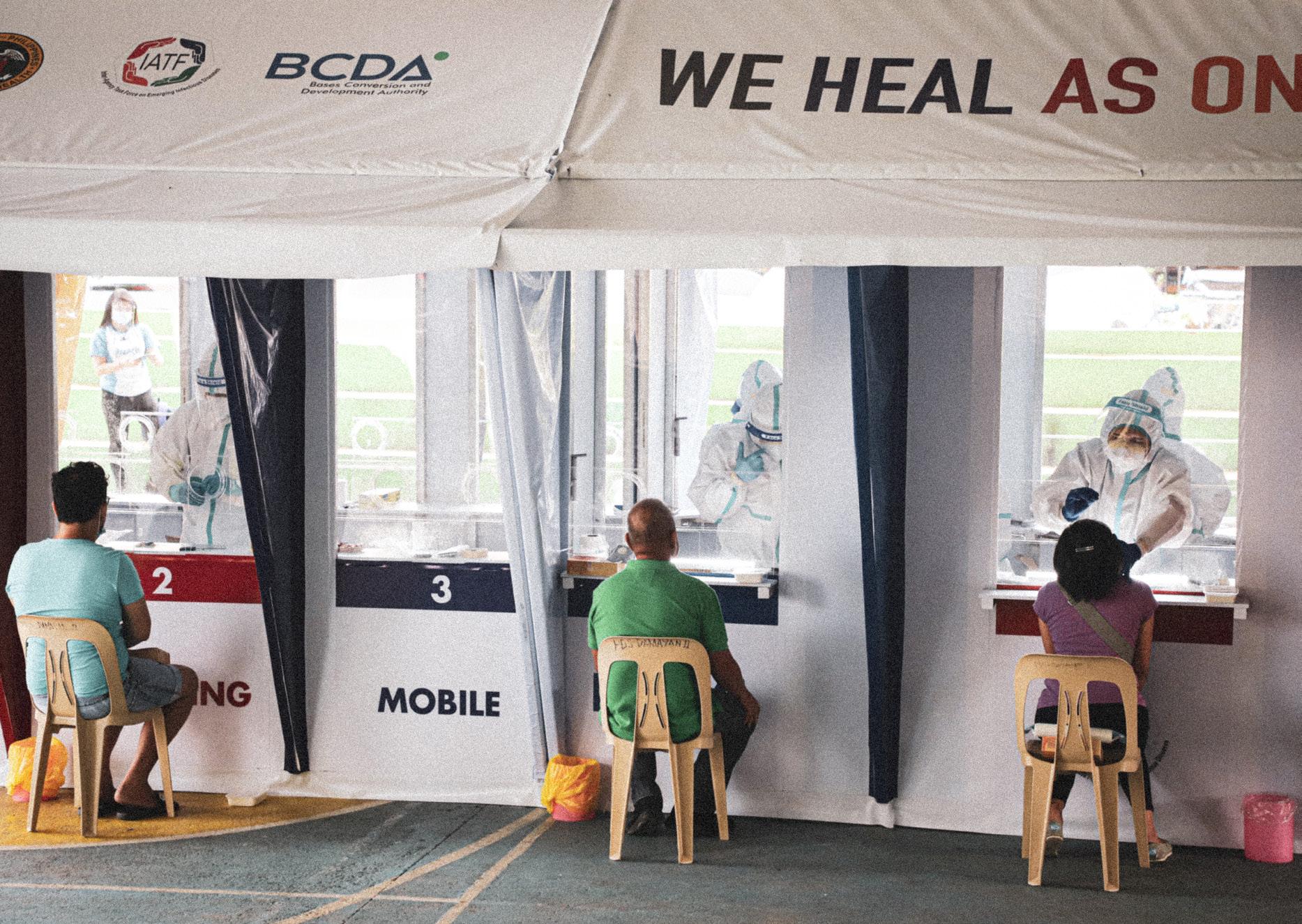
THE POWER OF VOLUNTEERISM
When the World Health Organization (WHO) declared the COVID-19 outbreak as a public health emergency of international concern, it triggered the repatriation of overseas Filipino workers (OFWs). However, the ones who arrived in the Philippines in March 2020 found the entire Luzon island under enhanced community quarantine (ECQ). President Duterte had ordered the ECQ on March 16, 2020 over the island, home to more than 57 million, to try to ease the rising cases of COVID-19 in the Philippines.
As part of the ECQ restrictions, inter-city travel in Luzon was suspended, as well as transportation in and out of the island. This was troubling news particularly for the OFWs who had arrived at Clark International Airport in New Clark City as the lockdown began. The ones whose homes were outside Tarlac had no means to get there. They were stuck in the airport temporarily.
BCDA steps up
Consequently, BCDA President and CEO Vivencio B. Dizon and Vice President for Business
1
BCDA supports the aggressive community testing initiative by deploying volunteers to assist in the operation of mega swabbing centers and mobile swabbing facilities
Members of the Task Force Clark Safe Haven receive stranded repatriated OFWs at The Mansion
2
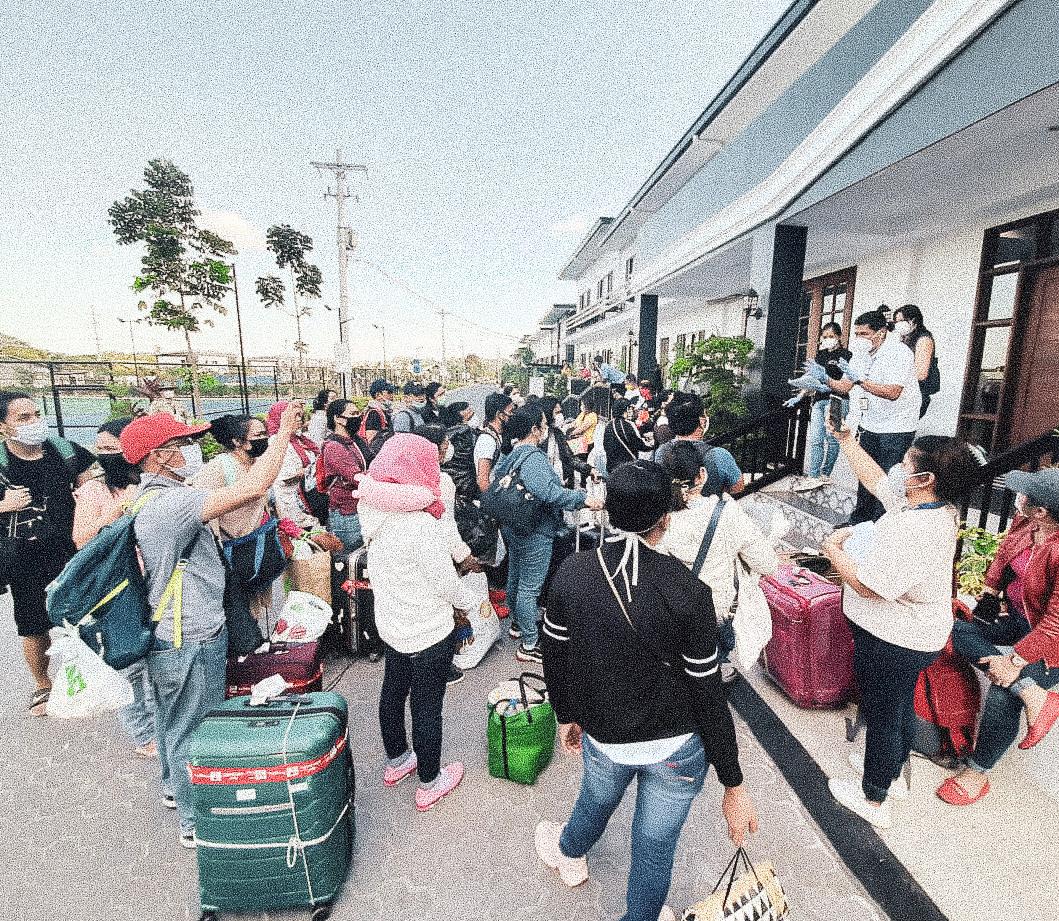
THE VOLUNTEERS' TASKS
△ Secure housing for people arriving at the Clark
International Airport △ Repatriate OFWs past border controls back to their homes in Visayas and
Mindanao △ Take charge of swabbing in
New Clark City and help out in Metro Manila △ Support the Aggressive
Community Testing (ACT) initiatives of the Philippine
Coast Guard (PCG), the
Philippine National Police, the Armed Forces of the
Philippines, and the Bureau of Fire Protection △ Man mega swabbing centers at the SM Mall of
Asia Arena, Ninoy Aquino
Stadium, and the Philippine
Arena △ Assist PCG’s ACT mobile teams in mobile test booths outside Metro Manila △ Help with waste disposal, janitorial services, food catering △ Aid in procurement of necessities for isolation facilities
2
Development Arrey A. Perez had their work cut out for them. Department of Health (DOH) Secretary Francisco Duque III and Foreign Affairs Secretary Teodoro Locsin, Jr. had asked BCDA for help in dealing with the arrivals. “The problem was, everyone was scared because, back then, there was still little information globally about what COVID-19 was,” said Perez. “There were no suppliers nor contractors because no one wanted to go out. And no one was adept at attending meetings over Zoom yet. So we took it upon ourselves.” The BCDA employees whose homes were in Metro Manila were the first to volunteer. Initially, there were less than five of them. Eventually, BCDA was supplying the COVID-19 effort in New Clark City with 60 volunteers, and then 100. When the government began issuing out rapid passes (to get through city borders), the BCDA volunteers were among the first ones to get them. From construction of swabbing facilities (and later on, of quarantine facilities) to their operations, BCDA was on top of it all. By December 2020, BCDA’s swabbing volunteers had helped test 666,696 individuals. Who would have thought that a relentless pandemic would be the setting for the heroism of BCDA’s volunteers, led by their president, Vince Dizon?
Oplan Kalinga
AN INTER-AGENCY ALLIANCE
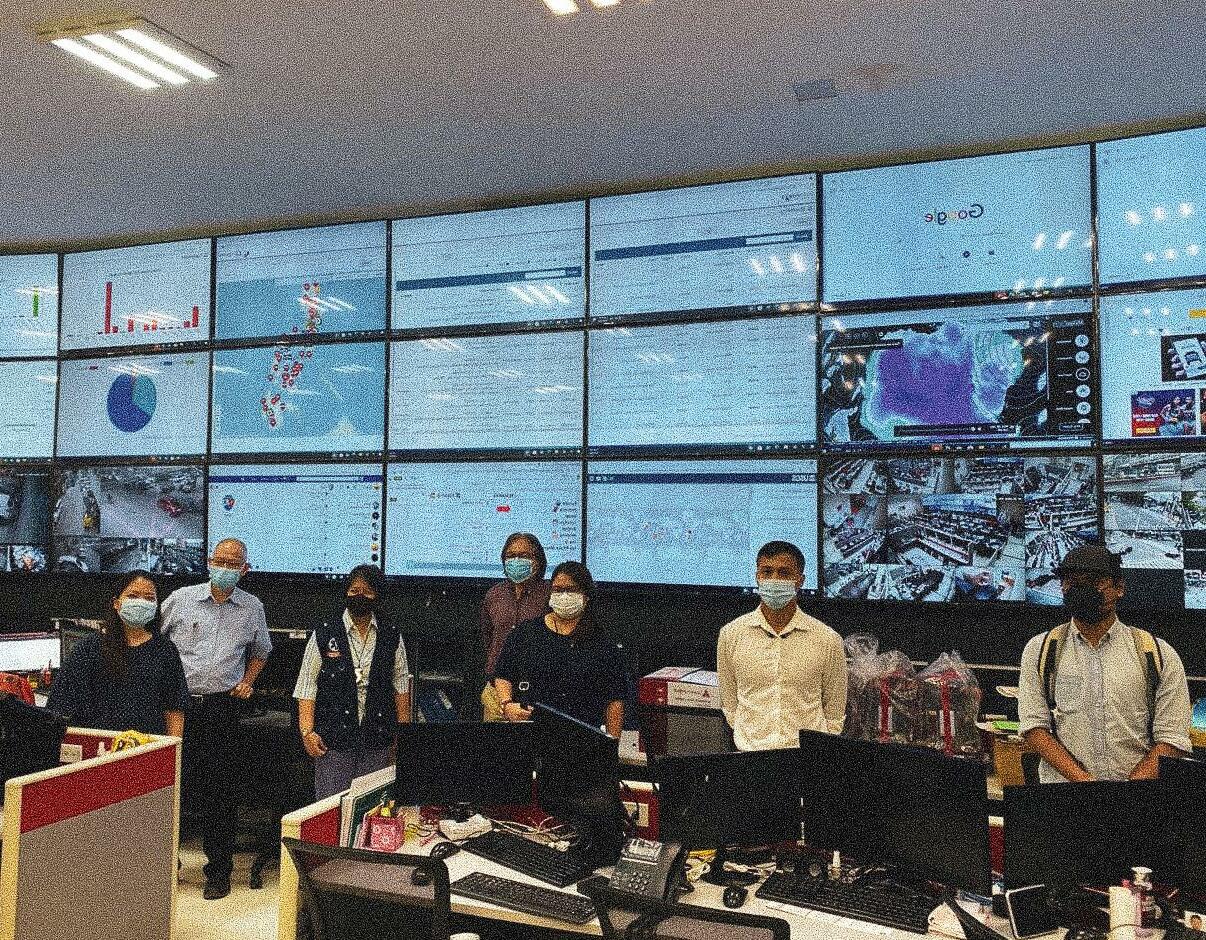
There was a surge of COVID-19 cases in June 2020, so the government stepped up isolation efforts, which eventually became known as Oplan Kalinga. Oplan Kalinga is headed by the Department of Health (DOH), Department of Tourism (DOT), Department of the Interior and Local Government (DILG), Metropolitan Manila Development Authority (MMDA), and BCDA.
By this time, the government had already determined the high-priority aspects of their containment effort and appointed “anti-COVID czars.” BCDA President and CEO Vivencio B. Dizon became the “testing czar”; Baguio Mayor Benjamin Magalong took charge of contact tracing; Public Works Secretary Mark Villar oversaw patient isolation efforts; and Health Undersecretary Leopoldo Vega took on the role of “treatment czar.”
Mandatory isolation
Oplan Kalinga’s main objective was to isolate the positive cases from the rest of their communities. The group achieved this by tapping hotels to serve as isolation facilities. “Since tourism was closed, hotels were eager to open up,” said Perez. This was in addition to the isolation facilities already constructed under the initiative of BCDA.
By April 2021, Oplan Kalinga had 24 hotels—with a total of 2,442 rooms—running as isolation facilities in different parts of the country. While most of them were concentrated in the National Capital Region, there were accredited facilities, as well, in the Cordillera Administrative Region, Region 4A, and Davao. Most of these facilities were used for asymptomatic and mild cases. By the end of April, the facilities were running with an average occupancy rate of 81 percent. “Oplan Kalinga worked because of inter-agency cooperation,” said Perez. “Some government agencies that weren’t supposed to be involved still pitched in. BCDA, the Department of Tourism, MMDA—it wasn’t part of our tasks to be involved. Under the law, it was only supposed to be the Department of Health, Office of Civil Defense, and the National Disaster Risk Reduction and Management Council. That’s where I saw that it was really a wholeof-government approach.”
1
StaySafe.ph app is launched on September 3, 2020. 2
A mobile swabbing facility set up at the Quezon City Memorial Circle for Grab drivers and public utility vehicle drivers
1
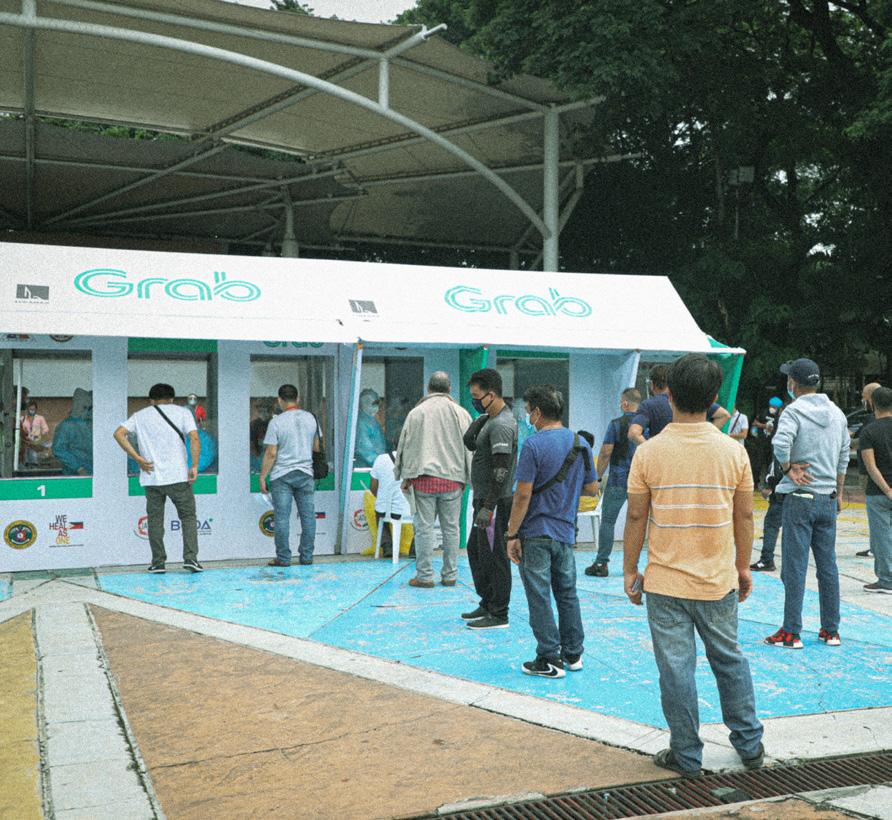
The Perfect Alliance
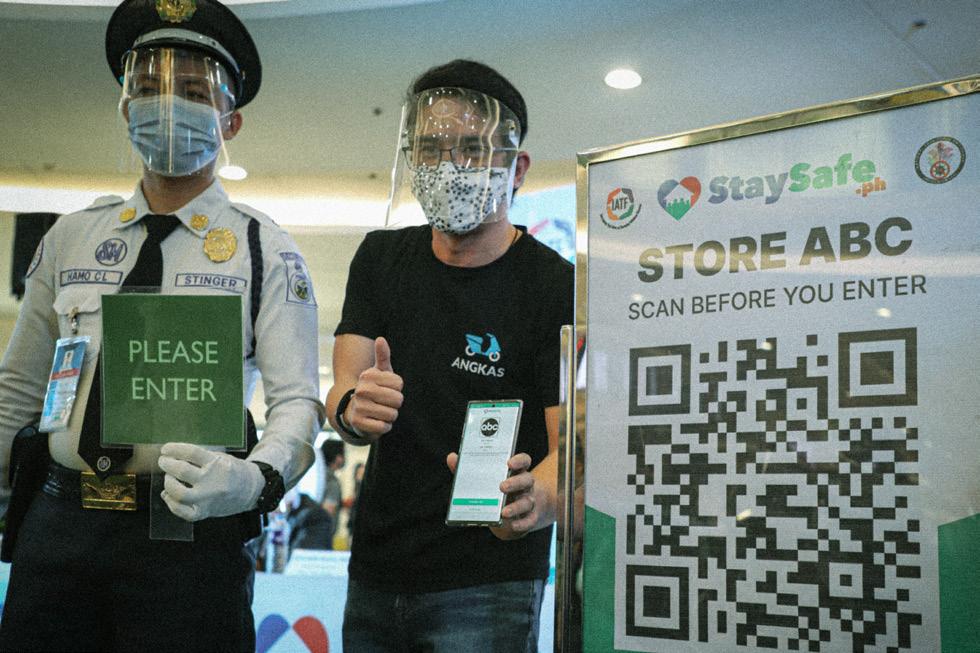
Task Force test, trace, treat (T3) was initiated in April 2020 by the Inter-Agency Task Force–National Task Force (IATF-NTF) and DOH, with support from the Asian Development Bank (ADB). Overseen by its chief coordinator, BCDA President Dizon, the funding, operations, and logistics were led by the private sector through large private conglomerates, including Ayala, Filinvest, Megaworld, and Vista Land.
T3'S GAME PLAN MAJOR SUCCESSES
Increase contact tracing and testing
Determine and fulfill the urgent requirements for polymerase chain reaction machines, testing kits, and fixed and mobile laboratories
Install equipped laboratories in priority hotspots as quickly as possible
2
△ Procured millions of testing kits △ Constructed new laboratories, increasing testing to 30,000 daily Free RT-PCR (reverse transcription polymerase chain reaction) swab testing for around 60,000 Grab drivers. Eventually, this was extended by national testing czar Vivencio B. Dizon to include jeepney, tricycle, and bus drivers. △ Built major quarantine facilities nationwide Ingat Angat: a national campaign meant to isolate COVID-19 patients △ Carried out digital contact tracing nationally
StaySafe.ph: an online contact tracing app created by Manila-based developer Multisys. △ Built consumer confidence to reopen the economy
Ingat Angat Tayong Lahat is a private sectorfunded multimedia campaign, which aims to encourage consumer confidence. It is led by
McDonald’s Philippines’ managing director Margot
Torres. △ Procured, stored, and rolled out COVID-19 vaccines to millions of Filipinos
T3’s communications team, led by Torres, raised vaccine willingness from 16 percent to 44 percent within four months.
Jollibee Foods Corporation chief sustainability and public affairs officer Jose "Pepot" Miñana provided the vaccination simulation plan.








